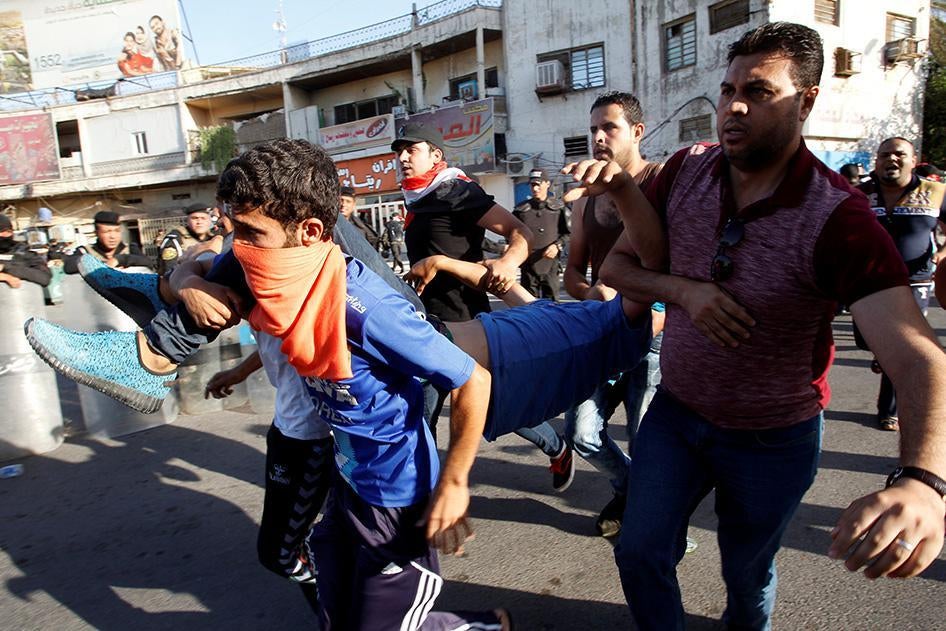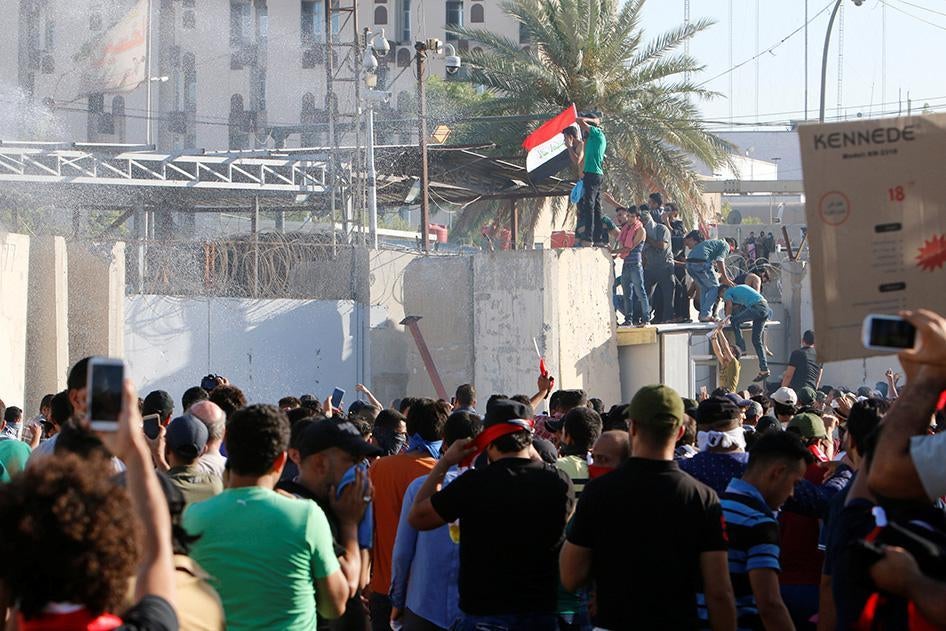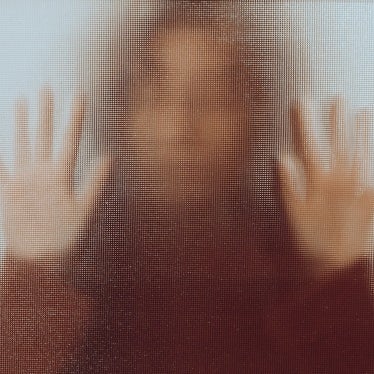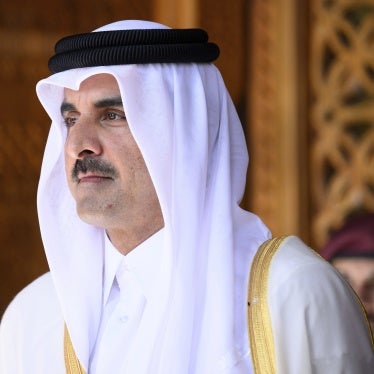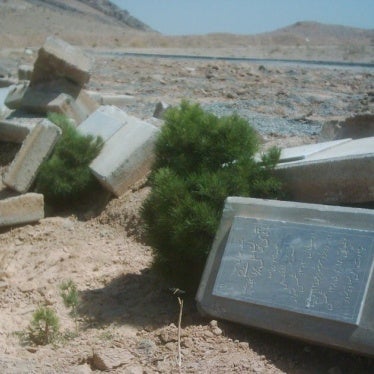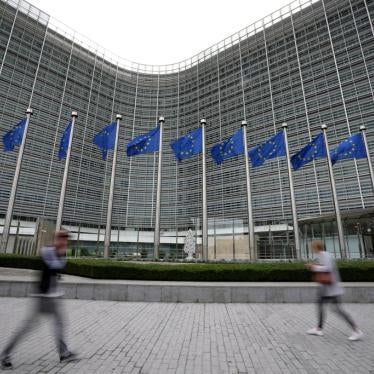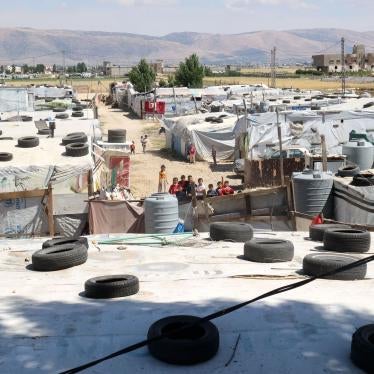(Beirut) – Iraqi security forces fired bullets and teargas canisters at peaceful protesters in Baghdad’s Green Zone on May 20, 2016, killing four people and wounding more than 100. Iraqi authorities should investigate the use of lethal force against the peaceful protesters.
Twelve witnesses from among the protesters told Human Rights Watch that the protesters were unarmed and peaceful when security forces opened fire. Some threw teargas canisters back at security forces or threw rocks after security forces opened fire. Human Rights Watch reviewed footage and photos from the protests, and none showed protesters carrying arms.
“Security forces protecting the Green Zone had no legitimate reason to fire on protesters who presented no risk to their lives or others,” said Joe Stork, deputy Middle East director. “The government should urgently investigate the killings and order security forces not to use lethal force unless absolutely necessary to save lives.”
The May 20 protest was the most recent in a series of mass demonstrations against government corruption and incompetence that began in July 2015. They escalated in February when the Shia cleric Muqtada al-Sadr called for his followers to join, which they did in the tens of thousands. On April 30, protesters for the first time scaled the walls of the Green Zone and briefly occupied the parliament building, causing some damage and roughing up several members of parliament.
On May 22, Saad al-Hadithi, spokesman for Prime Minister Haider al-Abadi, in a broadcast on state television denied that security forces had used live ammunition during the operation. Al-Hadithi said gunmen had infiltrated the demonstration. Human Rights Watch contacted the prime minister’s office for further details but received no response.
One protester, Hussein Muhammad Hasan, died from a bullet fragment to the head, according to the death certificate, which Human Rights Watch obtained. A second protester died from two bullet wounds that entered his liver and heart, said a neighbor who spoke to the family when they received the body. The death certificate lists a bullet in the chest as the cause of death. The victim’s family asked Human Rights Watch not to name him. Human Rights Watch was not able to obtain the death certificates for Jamal Jalil Novan and Muntadhar al-Hilfi, the other two protesters whom witnesses said were also killed at the demonstration.
The United Nations Office of the High Commissioner for Human Rights (OHCHR) reported that up to 200 protesters were wounded and another 200 subsequently arrested. Human Rights Watch was not able to confirm the number of wounded.
Witnesses told Human Rights Watch that protesters began to gather in Tahrir Square at about 3:45 p.m. The protesters included families of more than 200 people harmed in bombings in Baghdad in May by the extremist group Islamic State (known as ISIS), according to participants and the OHCHR. The families expressed anger over the government’s failure to protect them from the bombings.
Witnesses said that anti-riot police in the square blocked protesters from crossing Jumhuriyya Bridge over the Tigris River to the gates of the heavily fortified Green Zone, where government institutions and many foreign embassies are located. The anti-riot police in the square and Iraqi army forces on the bridge eventually allowed hundreds of the protesters to cross after searching them one-by-one.
At one entrance to the Green Zone, just across Jumhuriyya Bridge, hundreds of protesters gathered, waving Iraqi flags, shouting “Peaceful! Peaceful!” and demanding to enter with the families of bombing victims at the front, several protesters said.
Several protesters who were at the Green Zone entrances said that between 4 and 4:30 p.m., anti-riot police and soldiers from the army’s 56th Brigade opened fire on the protesters without warning. They said the security forces used live ammunition, rubber bullets, teargas canisters, and sound bombs, along with two water trucks parked inside the Green Zone.
“I arrived at the barricades to the Green Zone and after about 15 minutes, security forces opened fire on us, shooting directly at us,” one protester said. “I saw people fall to the ground left and right, including two who I later learned died.”
Another protester said that a projectile grazed his right cheek as he stood in front of the Green Zone with an Iraqi flag.
One protester said that several protesters banged on two of the doors in the barricade. Eventually security forces opened the doors and let them through. This protester said that when he entered the Green Zone a security officer wearing a gas mask hit him in the shoulder with the butt of his rifle, knocking him to the ground, and hit him again as he lay on the ground. When Human Rights Watch met him on May 23, his right shoulder was freshly bandaged and showed signs of abrasions.
Two videos viewed by Human Rights Watch show several hundred protesters in front of the General Secretariat of the Prime Minister’s Office presenting flowers to army officers tasked with protecting the Green Zone.
Two protesters said that some time later security forces inside the Green Zone opened fire on the protesters in front of the General Secretariat, chasing them out of the Green Zone. The security forces kept shooting at those fleeing and those still gathered outside, and pursued them in various directions, north and also west back across Jumhuriyya Bridge toward Tahrir Square.
One protester had a live bullet cartridge she said she picked up at the Green Zone-end of the bridge. Another said that he heard the shots from Tahrir Square and made his way toward the Green Zone: “As I was on the bridge I saw a young man get shot as he was running in the opposite direction.” All the protesters who spoke to Human Rights Watch said that the gunfire continued for about two hours. The protester wounded in the shoulder said that at the hospital he saw doctors extract bullets from scores of wounded protesters.
A protester who said he stayed in Tahrir Square said that he saw anti-riot police block two ambulances at the square from crossing the bridge toward the Green Zone entrance for about half an hour before letting them through. One said he saw at least 50 people lying wounded on the ground in front of the International Zone entrance and in front of the parliament, while another said he saw more than 100.
Under the UN Basic Principles on the Use of Force and Firearms by Law Enforcement Officials, the authorities should “as far as possible, apply non-violent means before resorting to the use of force and firearms.” The “intentional lethal use of firearms may only be made when strictly unavoidable in order to protect life.” The Principles state that, in cases of death or serious injury, appropriate agencies should conduct a review and send a detailed report promptly to competent administrative or prosecutorial authorities.
The government should ensure that arbitrary or abusive use of force and firearms by law enforcement officials is punished as a criminal offense. Superior officers should be held responsible if they knew or should have known that personnel under their command resorted to the unlawful use of force and firearms but did not take all measures in their power to prevent, suppress, or report such use.
“Iraqi authorities should order all security forces engaged in law enforcement duties to end the excessive use of force, especially lethal force, and hold accountable those responsible, including their commanders,” Stork said.
